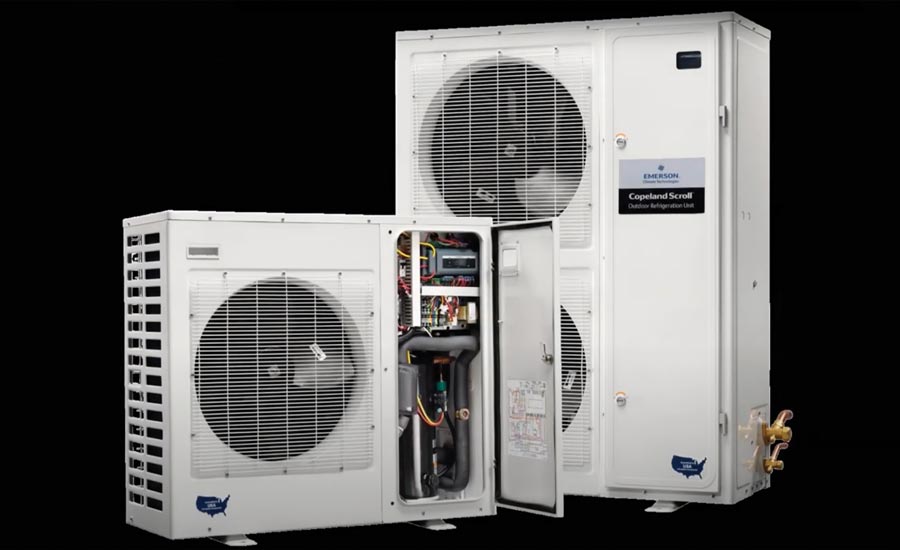A look around the world of condensers these days shows three factors driving changes: progress in technology, feedback from contractors or owners, and regulatory changes. As a result, even a quick survey turns up more advances than one might expect.
Vapor Injection and Remote Control
Two examples of modern design and performance came courtesy of Carrier, in the company’s Infinity® 26 Air Conditioner with Greenspeed® Intelligence (Model 24VNA6) and the Infinity® 24 Heat Pump with Greenspeed Intelligence (Model 25VNA4).
The manufacturer said the heat pump has broken new ground in the industry’s ducted segment, in the form of a 5-ton variable speed heat pump working at 13 EER.
Lynn Turner, associate director for product marketing for Carrier, pointed out a design plus on the air conditioner side.
“The 5-ton air conditioner and heat pump include vapor injection that introduces subcooled refrigerant into the system to increase capacity while using little additional power.”
Both units feature variable-speed capacity down to 25 percent in one-percent increments. Reflecting industry trends in recent years, the range of manageable outdoor temperatures, both high and low, continues to expand as well.
Optimized compressor and blower speeds let this pair deliver 30 percent more dehumidification than previous Greenspeed models. This, in turn, is meant to translate to less cycling in extreme conditions, wider capacity range, and longer run times.
Finally, Carrier attacked equipment noise from several angles. A laminated compressor plate, two compressor sound blankets, vibration isolation compressor grommets, fan blade design, and a variable-speed fan motor all contribute. Meanwhile, Turner mentioned that the Quiet Mode touts sound levels “at or below 69 dB with no accessories required.”
At Rheem, the focus remains on improving performance and customer satisfaction through advanced remove capabilities, and that applies to condensers.
Lily Mak, product manager at Rheem, touted the company’s EcoNet®-enabled line of equipment. The equipment-focused benefit of the technology, she says, is the ability to “detect and provide alerts for issues that will ultimately impact condenser efficiencies and life expectancy.
“The ability to catch and fix functional issues in advance of system failure,” Mak said, “is a huge advantage.”
On the customer-facing side, remote monitoring may mean more to rental or second-home owners in an era of reduced travel. However, the EcoNet app’s convenience remains even if one is just upstairs on the sofa.
Compliance and New Regulations
As it often does, the New Year brought with it some new environmental regulations. The class of 2020 on the nonresidential side included the Department of Energy’s Annual Walk-In Energy Factor (AWEF).
This ruling affects condensing units serving walk-ins up to 3,000 square feet in size, and it covers all the major scenarios: units for new walk-ins, units used in walk-in cooler or freezer retrofits or repairs, and those working as part of a packaged system.
As a maker of components found in other manufacturers’ systems, Emerson responded with a new platform of AWEF-compliant condensing units. This equipment can be found either paired in OEM systems for AWEF-compliant coolers or stocked individually for replacement jobs.

ORBIS: Designs reusable beverage pallets typically used by can and bottle manufacturers.
More recently, Emerson’s own Copeland Scroll brand offered its X-Line Series, designed for medium-temperature walk-in coolers and display cases.
These rely on large-capacity condenser coils and variable-speed fan motor control for continuous modulation from 20 to 100. The result is also reduced compressor cycling and lower energy consumption. These units are designed to maintain box temperatures within a half degree Fahrenheit and can be applied to multiple evaporator systems, according to the company.
Fruits Of Feedback
Mechanical space remains at a premium in many areas. Due to a design priority on slim profile and minimized weight, the X-Line series can be wall-mounted, offering increased installation flexibility for contractors dealing with tight spaces.
Store owners, facility managers, and contractors may appreciate the onboard diagnostics and the alerts that can work independently or coordinate with a facility’s control system.
As for Carrier, Turner said the air conditioning and heat pump options above offer “flexibility up to 250 equivalent feet of refrigerant line length.”
She went on to emphasize the company’s efforts to counteract the ongoing technician shortage by saving trips and time through an upgraded service app. It is designed to let contractors work through over 130 diagnostic codes and fault trees to pinpoint an actual problem.
Furthermore, the equipment’s software can be field-upgraded three ways: through a Wi-Fi-enabled wall control, by SD card update at that same control, or remotely by using the service app paired to a Bluetooth module at the outdoor unit. That last capability may have seen its value rise unexpectedly this year, as customers and contractors alike look for ways to take care of equipment while minimizing direct interaction.



Report Abusive Comment